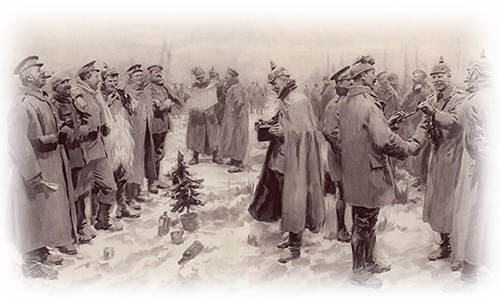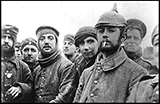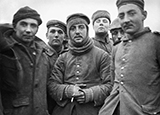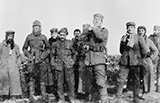
In the final days of World War I’s first year, it was becoming clear to soldiers on both sides that this was not going to be the quick, decisive war they were promised. With hundreds of thousands of troops already wounded, dead, missing, or captured, the soldiers entrenched on the Western Front found themselves longing for home, friends, and peace. On December 24, 1914 the dream of peace, as brief as it was, would become a reality for many soldiers scattered across Belgium and France when an informal Christmas Truce began to spread to parts of the Western Front.

British soldiers from the 11th Brigade, Fourth Division and German soldiers during the Christmas Truce.
In the early months of the war it was not that unusual to have informal truces. Often, these truces would occur so dead bodies could be collected from No Man’s Land. Sometimes truces were scheduled for daily routines like meals being brought to the front lines. In the week leading up to Christmas, 1914 soldiers on both sides began to exchange Christmas pleasantries across the battlefield. This was achieved early on by taking turns singing Christmas carols or yelling greetings across the trenches.
Appeals had been made by citizens and officials within the fighting countries for a truce during Christmas. One such incident occurred when Pope Benedict XV requested an official truce be granted out of respect for the Christmas holiday. Despite such heartfelt appeals, military officials either refused or simply ignored such demands.

British soldiers from the 11th Brigade, Fourth Division and German soldiers during the Christmas Truce.
Undeterred, the soldiers officially began what would become The Christmas Truce on Christmas Eve near the Belgian town of Ypres. German soldiers began decorating their trenches with candles and Christmas trees as they sang carols. The nearby British soldiers responded with carols of their own. Eventually, a few brave souls slowly began making their way across No Man’s Land toward their enemy’s trench. Risking their lives for goodwill, they exchanged greetings and small gifts like tobacco, food items, and alcohol. Realizing it was safe, more soldiers began to cross No Man’s Land and greet their enemies. Some sectors of the Western Front reported the two sides even engaging in friendly games of soccer. In total, approximately 100,000 German and British soldiers participated in the Christmas Truce of 1914.
Although the truce was mostly between the Germans and British, there was limited participation from the French. For the most part, though, French soldiers avoided fraternizing with the Germans. After all, there was already a deep rooted dislike for the Germans and they were invaders in French territory. Some French soldiers did hand off letters to the German soldiers requesting they send them on to friends or family in German occupied parts of France or Belgium.

German soldiers of the 134th Saxon Regiment and British soldiers of the Royal Warwickshire Regiment meet in no man's land, December 26
In many sectors, the truce lasted through New Year’s Day. Resuming battle became difficult after becoming so friendly with one's enemy. By the New Year, however, high command had "discovered" the widespread truces and put an end to the festivities. British Captain JC Dunn later wrote, “At 8.30 I fired three shots in the air and put up a flag with "Merry Christmas" on it, and I climbed on the parapet. He [the Germans] put up a sheet with "Thank you" on it, and the German Captain appeared on the parapet. We both bowed and saluted and got down into our respective trenches, and he fired two shots in the air, and the War was on again.”
The Christmas Truce of 1914 was not destined to be repeated. The following year, strict orders were issued from high command forbidding any fraternization with the enemy. By 1916, however, the brutal battles at the Somme and Verdun discouraged what remained of any desire to fraternize with the enemy. As the war progressed, both sides began to view each other with a growing sense of disdain and hatred. Later years of the war saw each Christmas Eve filled with bombardments to prevent soldiers from crossing No Man’s Land. Soldiers were also rotated more frequently to prevent fraternization. Although a few more informal truces would occur before the Armistice in 1918, none would match the festive and widespread nature of Christmas, 1914.
-WD
Related Lesson Plans
Further Reading
- First World War.com: Christmas Truce
- Eyewitness to History- Christmas Truce
- Letter from British general describes 1914 Christmas Day truce
- The Real Story Behind the 1914 Christmas Truce
- Imperial War Museum- Christmas Truce
First Posted: 12/04/2014


